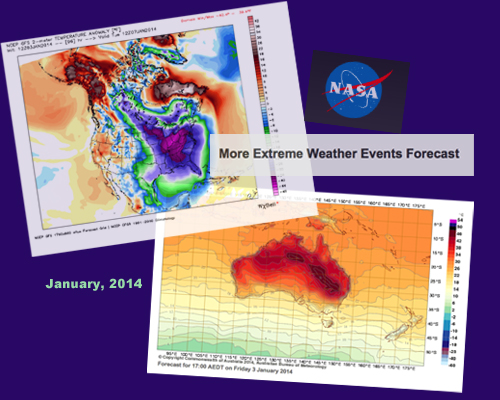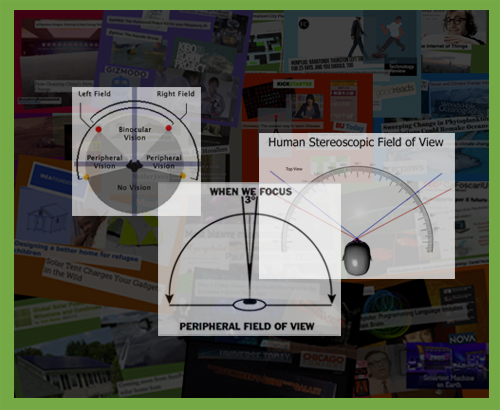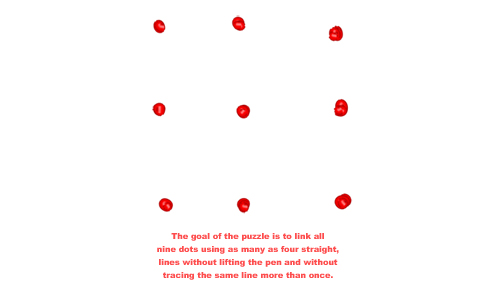| Oh b’rrrrrr. It’s January in Chicago and it’s snowy and cold outside. No news there. But when the temperature dips from the merely miserable into the realm of record-breaking arctic awful, it is the only news that matters. Snow at least can be shoveled. But 15 degrees below zero—with a wind chill “real feel” of 40 below—requires a full scale tactical retreat. Unless, of course, you happen to be a polar bear at Lincoln Park Zoo, in which case, it feels just like home. Or it should. It’s a bit of the North Pole come to visit. In weather-speak, the polar vortex is a hurricane of frigid air that swirls around the arctic circle. For yet undetermined reasons, it weakened, flinging off a huge plume of coldness (or, as the Weather Channel’s Mike Seidel put it, “a big blob of bitter”) that will soon cover half of North America. Despite the obvious irony, many suspect global warming probably played a role in this. . It is certainly to blame for the record-breaking heat currently roasting Australia where temperatures in the 120s (F) have become all too common. "…The week-long heatwave that has gripped central Australia has ensured 2014 has started where 2013 left off. In its annual climate statement yesterday, the weather bureau reported that Australia experienced its hottest year on record last year, with average mean temperatures 1.2C above the long-term average of 21.8C. Last year also recorded the hottest day on record, the warmest winter day and the warmest January and September since records began more than 100 years ago. Sydney and Hobart both recorded their hottest days on record…” — “Brisbane braces for scorching heatwave” / The Australian, 1/4/2014 Gavin Schmidt, a climatologist at NASA’s Goddard Institute for Space Studies, looks at longer range patterns for climate trends. "What matters is this decade is warmer than the last decade, and that decade was warmer than the decade before. The planet is warming. The reason it’s warming is because we are pumping increasing amounts of carbon dioxide into the atmosphere." —More Extreme Weather Events Forecast / NASA The result is record-smashing weather. While England has been battered this winter by a series of storms whose high winds and torrential downpours have led to catastrophic flooding and the Philippines is still in shock from its brush with the largest typhoon to make landfall in recorded history, California, number one for agriculture in the US, is entering its fourth year of drought. Too cold, too hot, too wet, too dry, too much. Today’s high in Chicago is predicted to be the lowest ever: 10 degrees below zero. In Longyearbyen, Svalbard, north of the arctic circle, it will be a balmy 5 degrees above. What’s wrong with this picture? THE VIEW FROM INSIDE Whipped into a preparedness frenzy by wall-to-wall weather coverage, most area schools have extended the winter break by at least a day and those who can are working from home or taking the day off. For the next day and a half, I will mostly be in the cozy cocoon of my kitchen. As long as the wifi holds, I am in business. A couple of weeks ago, hundreds of thousands of homes and businesses from Michigan to Toronto to Maine weren’t so lucky when a record-breaking ice storm made hash of the power grid. Tree limbs snapped cables and transformers shorted out. It took over a week to make repairs, with crews from all over the country coming to the rescue. Repair costs are still being tallied but will likely run into the hundreds of millions of dollars, which at least in Maine, will likely be passed along to consumers. Vermont is angling for some federal aid. No matter who covers that bill, it doesn’t include the cost to businesses that were forced to close, or property damage from frozen water pipes, or the expense of having to buy generators or move to a temporary shelter. The kicker is that it could happen again. The repaired grid is just a vulnerable as ever. Not only ice, but fire, heat (see Australia), lightning, wind and heavy rains can bring down a grid. So can a good solar storm. Or terrorists. …“We are woefully unprepared for any large-scale geographic outage that might take place over an extended period of time,” explained Joel Gordes, research director for the U.S. Cyber Consequences Unit, an independent group that assesses the danger of such attacks and what it would take to thwart them. He said that while some generators and transmission lines probably would survive such an attack, they might not be able to muster enough juice to reboot the grid, which experts call a “black start.” And if critical equipment is damaged beyond repair, it might be necessary to transport replacement units long distances—an undertaking that would be difficult, if communications systems were also seriously damaged by the attack…. — "American Blackout": Four Major Real-Life Threats to the Electric Grid / National Geographic It seems impossible, but it gets worse. Beyond the vulnerability and inefficiency of the grid (an estimated 7% of electricity is literally lost in transmission), it is in poor repair. Most of the transformers in the US were installed 20 to 30 years ago and need to be replaced, but the pool of transformer-savvy workers is shrinking fast: "…It is a fact that technical and skilled workers that truly understand the ins and outs of power transformers are approaching retirement. Their important skills and talents are fading from the work force. This diminishing resource includes electrical engineers who in past decades had selected this field of study in college, but now are pursuing more alluring careers in new fields like smart-grid automation and computer science. Concerning manufacturing and repair, designing and fabricating transformers is a labor-intensive activity requiring special skills acquired from years and years of hands-on experience. There are simply too few mentors providing the necessary apprenticeships. Training costs have also risen. The labor force committed to maintaining and servicing these transformers is experiencing the same labor and skills shortages as the fabricators working in the shops. This includes special skills in fluid processing, electrical testing, vacuum filling, and oil testing – skills that can take years to develop including rigid safety requirements. — "The Perfect Storm in Transformer Maintenance" / Bob Rasor, SD Myers, Inc. / Electric Energy Online Why keep pouring good money after bad? THINK DIFFERENT: POWER EDITION Later this year, when the ratepayers of Maine find themselves on the hook paying for a power outage that has already cost them so much, some will look to California for a better idea—one that could literally change the balance of power. The key piece of the puzzle turns out to be a car battery. Elon Musk, founder and CEO of Tesla Motors, also happens to be Chairman ofSolarCity, a company that leases solar panels. Adding a Tesla S battery to the lease package allows customers to store power generated on their rooftops during the day to be used at night. By the time all the subsidies are accounted for, the customer gets more reliable power for less money and the SolarCity can still make a profit over the life the lease. There are still a few hurdles when it comes to hooking up the main power grid: "…PG&E, Southern California Edison and San Diego Gas & Electric – California three big utilities – however, have argued to regulators that such subsidized storage systems would saddle other customers with the cost of maintaining the power grid and thus they should be charged connection fees. In California, homeowners already receive a credit for the solar electricity they send to the grid that is used to pay for the power they use when the sun isn’t shining. If homeowners can hook up batteries to their solar arrays, the utilities asked, what’s to stop them gaming the grid by storing electricity from the transmission system when rates are low and then selling it back to the utilities when rates are high?…" —”Why You Might Buy Electricity From Elon Musk Some Day” / Todd Woody / The Atlantic Never mind that electric companies have already gamed the system by charging more for energy when demand is high no matter what it costs to procure. Given the massive upgrades required for the grid, it would simply be a smarter move to “pivot,” as they say in tech, and rethink the business model altogether. The shift to distributed generation not only reduces the need for large central power plants, but also the need for massive regional grids to distribute the power that is no longer generated by those plants. Instead, microgrids could be configured for a building or a street or a neighborhood, boosting efficiency, cutting costs, decreasing vulnerability and increasing resilience. What’s not to love? For the time being, the California Public Utilities Commission is recommending that connection fees only be applied when a battery system can store more power than can be produced by a solar array (otherwise, the battery could be charged up when grid electricity rates are low and the power sold back when rates are high). The bottom line is that no one can afford the old way of doing things. It’s too expensive and it’s wrecking the climate. Renewable energy plus battery storage plus microgrids equals lower bills and fewer greenhouse gas emissions. And, if we are lucky, a future where the polar vortex knows where it belongs. — J.A. Ginsburg / @TrackerNews RELATED: Ice storm most ‘devastating’ event to hit Toronto’s trees, climatologist says / Tim Alamenciak / Toronto Star U.S. Electrical Grid on the Edge of Failure / Jeff Tollefson and Nature magazine / Scientific American Separating Fact from Fiction In Accounts of Germany’s Renewables Revolution / Amory Lovins / RMI Europe’s Fossil Fuel Exit — 30% Of Fossil Fuel Power Capacity To Close By 2017, UBS Analysts Project / CleanTechnica How Microgrids are Bolstering the Nation’s Power Infrastructure / Justin Gerdes / Smithsonian magazine Elon Musk: A Giga Factory For Electric Vehicle Batteries Needs To Be Built / Dana Hull / San Jose Mercury News |
|
0 Comments
|
BackgroundDot to Dot grew out of the TrackerNews Project, a demo news aggregator developed for InSTEDD, an independent spin-off of Google.org's humanitarian practice that focused on health issues, humanitarian response and technology. Archives
• Bats, Trees And Bureaucrats: Ebola And How Everything, Positively Everything, Connects • Scrubba Dub Carlos and the Big Bad Enterovirus: Why Sneeze When You Can Sing? • Ebola, Bats and Déjà Vu All Over Again • Scaling Good: Project Frog’s Buildings And The Kitchen Community’s Learning Gardens • Thumbs Up And High Fives: Evolution, Hands And 3D Printing • Legos, Makers, Molecules, Materials And The Very Big Business Of Small Things • Solid: When Bits and Atoms Dance • Science Hack Day Chicago 2014: Reinventing The Space Suit, Cosmic Biomicmicry And The Joy Of Thinking Different • The Motors of August Cicadas • Mulling Snow, Climate, Pain Points, Bootstrapping And Chicago’s Advantage • Glass, Tech And Civilization: The Material That Makes Just About Everything Better • A Tale Of Two Maps And Why You Can’t Teach An Old Grid New Tricks • When Bad Things Happen To Good Content: Form(At), Function, Perspective And Possibilities • The Sum Of Its Parts: Autozone Meet Autodesk (Please) / On Supply Chains, Carbon Footprints And How 3D Printing Can Change The Game (Again) • It Takes An Economist: Tallying Natural Capital • Beyond Measure: Da Vinci’s Genius, Peripheral Vision, The Prepared Mind, Metric Traps And Hacking The Filter Bubble A Solstice Encore: Imaginary Carl Sagan, A Holiday Mix Tape And The Tannahill Weavers Categories
All
|







 RSS Feed
RSS Feed







